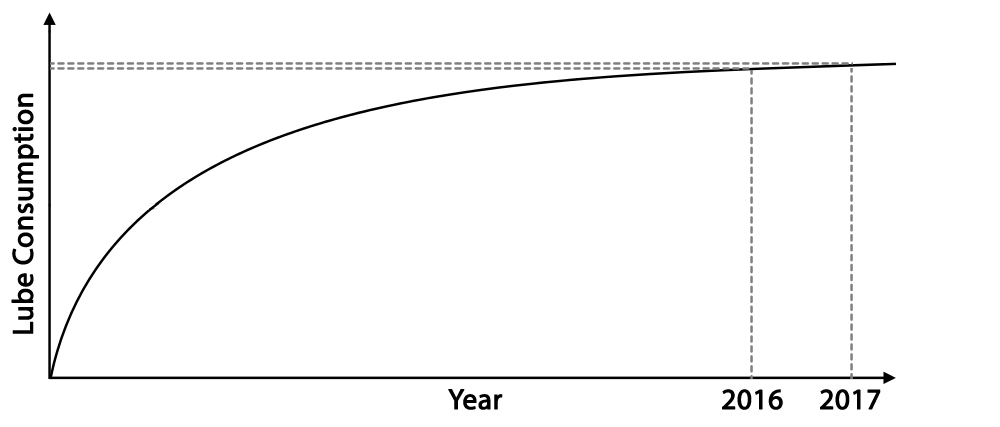Lube Demand Could Decrease
Ostfildern, Germany – Global lubricant demand reached 35.7 million metric tons in 2017, neck-and-neck with the year before, indicates an initial tally from Fuchs Petrolub SE. Perhaps 900,000 tons or more of that could evaporate in the coming decade, however, due to electric vehicles and other disruptive technologies, a company executive warned.
In a keynote address to the 21st International Colloquium Tribology on Jan. 9, Fuchs executive board member and Chief Technology Officer Lutz Lindemann said lubricants demand was estimated as “stable” for 2017 versus 2016, while adding that he perceives “some slight indications of overheating in the global economy – not a totally healthy sign.”
Lubricant suppliers face additional challenges on a number of fronts: electric cars, which have vastly different lubricant needs than internal combustion engines; sustainability and digitalization, which are influencing customers’ lubricant expectations and purchasing decisions; and 3-D printing, also known as additive manufacturing, which promises to gut traditional manufacturing industries.
Rapidly summarizing the global scene at year’s close, Lindemann reported that per capita consumption of lubricants worldwide now averages about 5 kilos per person.
Regionally, he said, 19 percent of this consumption arises from Western and Eastern Europe, where volumes have been on the wane for some time. Ten years ago, the continent’s users required 8.4 million tons of lubricants but by 2017 they had trimmed their appetite to just 6.8 million tons.
Some 28 percent of consumption comes from North and South America; while Asia-Pacific, the Middle East and Africa consume a combined 53 percent, versus 45 percent a decade earlier.
China stands out as the single largest country market, with 20 percent of global demand (about 7 million tons). Here, compound average annual growth had been 4.1 percent but now appears to be flattening, Lindemann told the gathering at the Technische Akademie Esslingen here.
Next-largest country market is the United States, with an estimated 6 million tons of demand and slightly declining CAGR of 1.2 percent, due to efficiency gains in vehicles and industry. India and Germany are also substantial markets.
“Looking at the top 20 lubricant suppliers,” he continued, “there are no significant changes, just the usual suspects.” Shell held on as the world’s number one manufacturer, followed in order by ExxonMobil, BP-Castrol, Chevron and Total. Fuchs counts itself ninth among the top 20.
Eyeing future trends, the Mannheim, Germany-based Lindemann pointed to several critical changes that will determine the winners and losers in the lubricant industry.
- Digitalization is bringing new players and new competition into the field. These players employ information technology to make business practices more efficient, and some are nudging their way into the lubricant industry. They advise clients about lubricant selection and usage, and could grow to challenge lubricant companies on their own turf, Lindemann said.
- 3-D printing will bring real disruption, he went on. “It eats the existing technology, just cannibalizes it.” The aerospace industry already employs 3-D printing to create large, complicated parts such as turbine blades, using zero metalworking fluid. The technology soon will move into car manufacturing, medical devices and steel fabrication, further eroding demand for the metalworking fluids, forming oils and corrosion preventives consumed by traditional metal shaping processes.
- E-mobility presents a mixed scenario, with Europe and Asia in the forefront of adopters, Lindemann said. In 2016, electric vehicles sales in the European Union were 206,000 units, only a 1.4 percent share. By 2028, his company estimates, the EU market could include 30 percent electric cars, an equal share of internal combustion engines, and 40 percent hybrids.
“E-mobility is positive in Asia-Pacific,” he added. China, for example, aims to have 10 percent of new cars be electric by 2019 and 12 percent from 2020 and beyond. By contrast, “e-mobility is down the drain now in the U.S,” stalled by a pending review of Corporate Average Fuel Economy targets promulgated under the prior administration.
Because e-cars have different lubrication needs, the effect on lubricants is difficult to gauge, Lindemann acknowledged. “There are 2,000 moving parts in an internal combustion engine, but only 200 parts in the electric vehicle.” Those fewer parts will not need as much industrial lubricant or metalworking fluid to manufacture, either.
On balance, Fuchs Petrolub expects factory-fill engine oil demand to shrink significantly, as will gear oil. On the plus side, the company anticipates increasing need for lubricating greases, which will have to meet stringent specifications for friction, speed, noise and yellow metal compatibility. Another winning segment could be battery-cooling fluids and lubricants for cooling other parts.
“The net effect worldwide will be a decrease of 900,000 tons in lubricant demand. At the end of the day, it won’t kill our world,” Lindemann said – but lubricant companies will have to adapt to the new realities.

